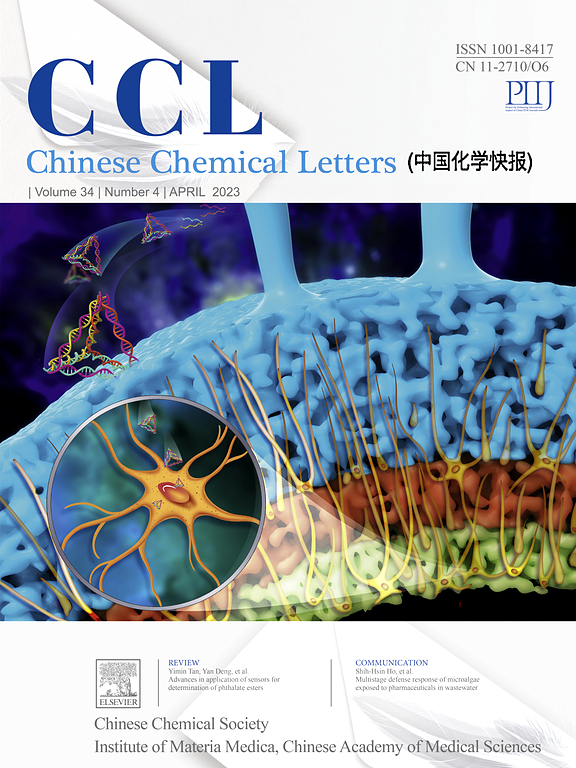Swelling and erosion assisted sustained release of tea polyphenol from antibacterial ultrahigh molecular weight polyethylene for joint replacement
IF 9.4
1区 化学
Q1 CHEMISTRY, MULTIDISCIPLINARY
引用次数: 0
Abstract
The considerable hazard posed by periprosthetic joint infections underlines the urgent need for the rapid advancement of in-situ drug delivery systems within joint materials. However, the pursuit of sustained antibacterial efficacy remains a formidable challenge. In this context, we proposed a novel strategy that leverages swelling and erosion mechanisms to facilitate drug release of drug-loaded ultrahigh molecular weight polyethylene (UHMWPE), thereby ensuring its long-lasting antibacterial performance. Polyethylene oxide (PEO), a hydrophilic polymer with fast hydrating ability and high swelling capacity, was incorporated in UHMWPE alongside the antibacterial tea polyphenol (epigallocatechin gallate, EGCG as representative). The swelling of PEO enhanced water infiltration into the matrix, while the erosion of PEO balanced the release of the encapsulated EGCG, resulting in a steady release. The behavior was supported by the EGCG release profiles and the corresponding fitted release kinetic models. As demonstrated by segmented antibacterial assessments, the antibacterial efficiency was enhanced 2 to 3 times in the PEO/EGCG/UHMWPE composite compared to that of EGCG/UHMWPE. Additionally, the PEO/EGCG/UHMWPE composite exhibited favorable biocompatibility and mechanical performance, making it a potential candidate for the development of drug-releasing joint implants to combat prosthetic bacterial infections.

抗菌超高分子量聚乙烯中茶多酚的膨胀和侵蚀辅助持续释放,用于关节置换术
假体周围关节感染带来的巨大危害凸显了在关节材料中快速开发原位给药系统的迫切性。然而,追求持续的抗菌效果仍然是一项艰巨的挑战。在此背景下,我们提出了一种新策略,利用膨胀和侵蚀机制促进药物负载的超高分子量聚乙烯(UHMWPE)的药物释放,从而确保其持久的抗菌性能。聚氧化乙烯(PEO)是一种具有快速水合能力和高溶胀能力的亲水性聚合物,它与抗菌茶多酚(表没食子儿茶素没食子酸酯,以 EGCG 为代表)一起被加入到超高分子量聚乙烯中。PEO 的溶胀增强了水对基质的渗透,而 PEO 的侵蚀平衡了封装 EGCG 的释放,从而实现了稳定释放。EGCG 的释放曲线和相应的拟合释放动力学模型都支持这种行为。分段抗菌评估表明,与 EGCG/UHMWPE 相比,PEO/EGCG/UHMWPE 复合材料的抗菌效率提高了 2 到 3 倍。此外,PEO/EGCG/UHMWPE 复合材料还表现出良好的生物相容性和机械性能,使其成为开发药物释放关节植入物的潜在候选材料,以对抗假体细菌感染。
本文章由计算机程序翻译,如有差异,请以英文原文为准。
求助全文
约1分钟内获得全文
求助全文
来源期刊

Chinese Chemical Letters
化学-化学综合
CiteScore
14.10
自引率
15.40%
发文量
8969
审稿时长
1.6 months
期刊介绍:
Chinese Chemical Letters (CCL) (ISSN 1001-8417) was founded in July 1990. The journal publishes preliminary accounts in the whole field of chemistry, including inorganic chemistry, organic chemistry, analytical chemistry, physical chemistry, polymer chemistry, applied chemistry, etc.Chinese Chemical Letters does not accept articles previously published or scheduled to be published. To verify originality, your article may be checked by the originality detection service CrossCheck.
 求助内容:
求助内容: 应助结果提醒方式:
应助结果提醒方式:


